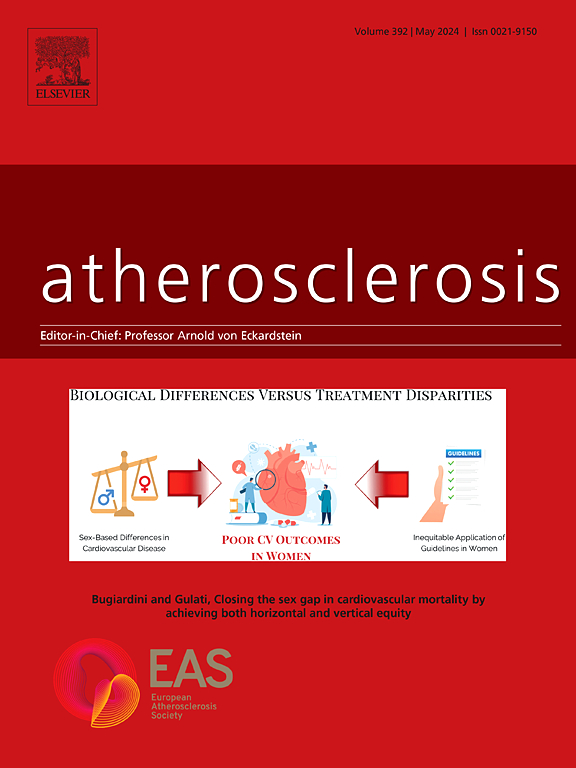高甘油三酯血症患者的小神经纤维损伤和心脏自主神经功能障碍
IF 5.7
2区 医学
Q1 CARDIAC & CARDIOVASCULAR SYSTEMS
引用次数: 0
摘要
背景,高甘油三酯血症(HTG)是1型、2型糖尿病和肥胖患者小纤维神经病变的独立危险因素。本研究评估了无糖尿病HTG患者的小神经纤维损伤和心脏自主神经功能障碍的证据。方法HTG患者(n=60)和年龄和性别匹配的对照组(n=31)进行了血脂、神经病变症状和残疾评估、角膜共聚焦显微镜(CCM)和心脏自主神经功能测试。结果甘油三酯(TG)浓度显著高于对照组(6.0 (3.6 ~ 8.7)vs 1.1 (0.7 ~ 1.4) mmol/L, p <;0.001),高密度脂蛋白胆固醇[0.9(0.7 - -1.2)和1.5(1.3 - -1.8)更易与L p & lt;0.001), HTG组较低。神经病变症状评分[2 (0 - 5)vs 0, p <;0.001],神经病变功能障碍评分[2 (0 - 3)vs 0, p <;0.001]和振动感知阈值[8.9 (5.5-10.5)vs 3.0(2.0-4.0)伏,p <;0.001]较高,而角膜神经纤维密度(CNFD) [28.9 (5.9) vs 35.1 (7.2)];/mm2, p <;0.001],角膜神经分支密度(CNBD) [50.0 (30.4-66.5) vs 76.1 (56.2-112.5)];/mm2, p <;0.001],角膜神经纤维长度(CNFL) [19.8 (4.8) vs 26.0 (6.2) mm/mm2, p <;0.001],深呼吸心率变异性(DB-HRV) [18 (13-20) vs 25(20-30)次/分,p <;0.001), E−我比[1.13(1.09 - -1.20)和1.25 (1.18 - -1.31),p & lt;HTG组的valsalva比值[1.29(1.18-1.49)比1.47 (1.28-1.59),p = 0.01]和30-15比值[1.24(1.16-1.36)比1.40 (1.27-1.49),p = 0.002]低于对照组。血清TG浓度与CCM参数和心脏自主功能测试呈负相关。结论htg与神经病变、小神经纤维损伤和心脏自主神经功能障碍的体征和症状相关,与糖尿病无关。本文章由计算机程序翻译,如有差异,请以英文原文为准。

Small nerve fibre damage and cardiac autonomic dysfunction in patients with hypertriglyceridaemia
Background & objectives
Hypertriglyceridaemia (HTG) is an independent risk factor for small fibre neuropathy in patients with type 1, type 2 diabetes, and obesity. This study assessed for evidence of small nerve fibre damage and cardiac autonomic dysfunction in individuals with HTG, without diabetes.
Methods
Participants with HTG (n=60) and age and sex-matched controls (n=31) underwent assessment of the lipid profile, neuropathic symptoms and disability, corneal confocal microscopy (CCM) and cardiac autonomic nerve function tests.
Results
Triglyceride (TG) concentration was significantly higher [6.0 (3.6–8.7) vs 1.1 (0.7–1.4) mmol/L, p < 0.001], and HDL-C [0.9 (0.7–1.2) vs 1.5 (1.3–1.8) mmol/L, p < 0.001) was lower in the HTG group. The Neuropathy Symptom Profile score [2 (0–5) vs 0, p < 0.001], Neuropathy Disability Score [2 (0–3) vs 0, p < 0.001] and vibration perception threshold [8.9 (5.5–10.5) vs 3.0 (2.0–4.0) volts, p < 0.001] were higher, whilst corneal nerve fibre density (CNFD) [28.9 (5.9) vs 35.1 (7.2) no./mm2, p < 0.001], corneal nerve branch density (CNBD) [50.0 (30.4–66.5) vs 76.1 (56.2–112.5) no./mm2, p < 0.001], corneal nerve fibre length (CNFL) [19.8 (4.8) vs 26.0 (6.2) mm/mm2, p < 0.001], deep breathing heart rate variability (DB–HRV) [18 (13–20) vs 25 (20–30) beats/min, p < 0.001], E−I ratio [1.13 (1.09–1.20) vs 1.25 (1.18–1.31), p < 0.001], valsalva ratio [1.29 (1.18–1.49) vs. 1.47 (1.28–1.59), p = 0.01] and 30–15 ratio [1.24 (1.16–1.36) vs. 1.40 (1.27–1.49), p = 0.002] were lower in the HTG group compared to controls. Serum TG concentration correlated negatively with CCM parameters and cardiac autonomic function tests.
Conclusion
HTG, independent of diabetes, is associated with signs and symptoms of neuropathy, small nerve fibre damage and cardiac autonomic dysfunction.
求助全文
通过发布文献求助,成功后即可免费获取论文全文。
去求助
来源期刊

Atherosclerosis
医学-外周血管病
CiteScore
9.80
自引率
3.80%
发文量
1269
审稿时长
36 days
期刊介绍:
Atherosclerosis has an open access mirror journal Atherosclerosis: X, sharing the same aims and scope, editorial team, submission system and rigorous peer review.
Atherosclerosis brings together, from all sources, papers concerned with investigation on atherosclerosis, its risk factors and clinical manifestations. Atherosclerosis covers basic and translational, clinical and population research approaches to arterial and vascular biology and disease, as well as their risk factors including: disturbances of lipid and lipoprotein metabolism, diabetes and hypertension, thrombosis, and inflammation. The Editors are interested in original or review papers dealing with the pathogenesis, environmental, genetic and epigenetic basis, diagnosis or treatment of atherosclerosis and related diseases as well as their risk factors.
 求助内容:
求助内容: 应助结果提醒方式:
应助结果提醒方式:


